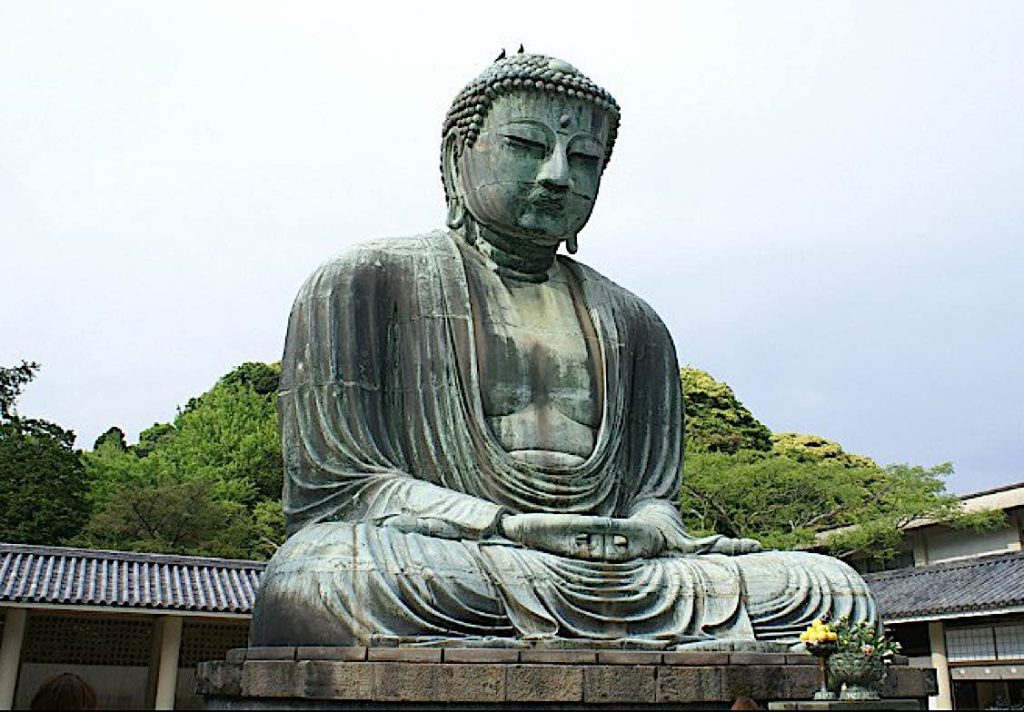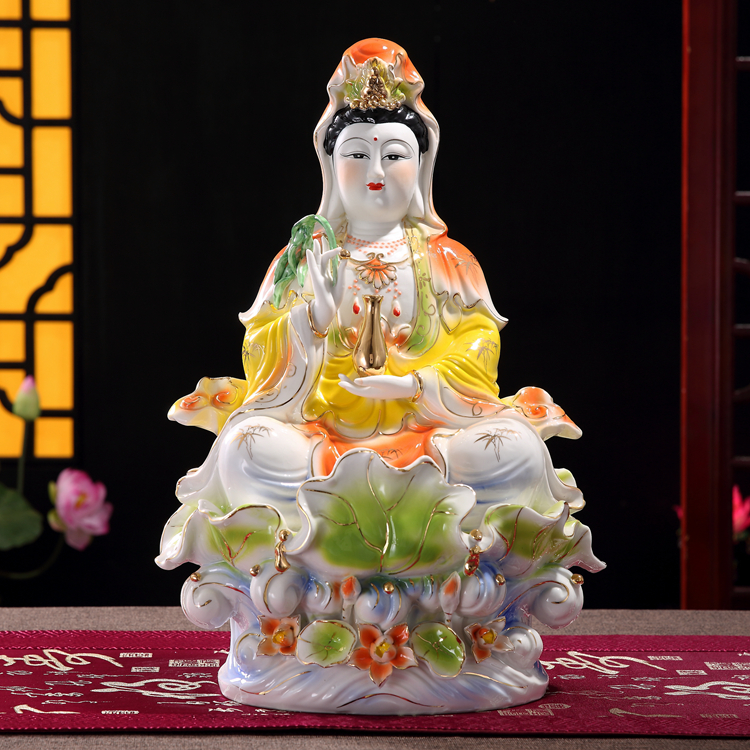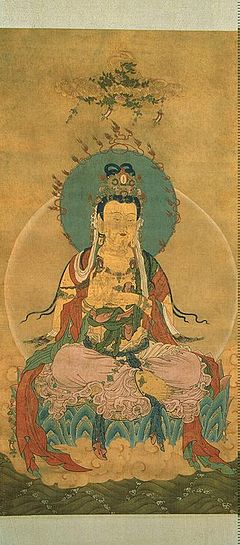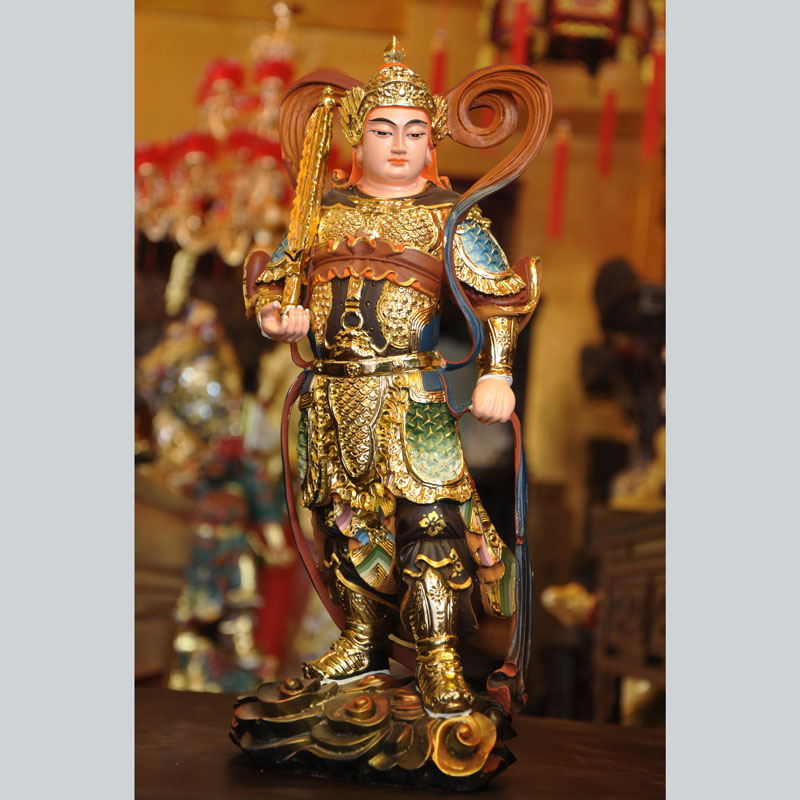Main Shrine Introduction

Who are the Buddhas enshrined in the main shrine and what do they signify?
Buddha, literally means the Enlightened One in Sankrit.
Bodhisattva is a being who is dedicated to achieving complete Buddhahood.
Sakyamuni Buddha

Sakyamuni Buddha (the seated Buddha) is the teacher and founder of Buddhism. Siddhartha Gautama (Sakyamuni Buddha’s secular name) was born as a wealthy prince around twenty six hundred years ago in Northern India. At the age of 29, even though he enjoyed a luxury life, Prince Siddhartha left his family and wealth, determined to search for the Truth and the solution for those who suffer from birth, aging, sickness, and death. After six years of practice, while meditating under a bodhi tree, he realized the Truth of the universe and the full insight in the way of life. This realization is known as Enlightenment. Upon reaching enlightenment, he was called Sakyamuni Buddha. Sakyamuni Buddha taught for 49 years after attaining enlightenment and upon his death (the physical body died) he entered into Nirvana (a conscious state of full liberation from the cycle of birth and death) at the age of 80.
Gautama Buddha was an ascetic and spiritual teacher of ancient India who lived during the latter half of the first millennium BCE. He was the founder of Buddhism and is revered by Buddhists as an awakened being whose teachings present and explain a path to freedom from ignorance, craving, rebirth and suffering
Amitabha Buddha

Amitabha Buddha (the standing Buddha in the middle) is the main teacher of the Western Pure Land. When he was a Bodhisattva (one who made the aspiration to awakening), he made 48 vows to establish the land of ultimate bliss, devoid of worldly miseries, for the sake of receiving all suffering beings. In the Western Pure Land, sentient beings will continue to receive the Teachings of Buddhas and Bodhisattvas until their attainment of Buddhahood. Buddhists commonly greet each other with Amitabha or “O Mi Tuo Fo,” which means “wish you with infinite life and light (wisdom).”
Amitabha, the Buddha of the Western Pure Land (Sukhavati)
Amitabha, The Buddha of the West
According to the legends, a long time ago, Amitabha used to be a king. He renounced his throne to be a monk called Dharmakara Bodhisattva.
Amitayus, the Buddha of Eternal Life, is also known as Amitabha, one of the five Cosmic Buddhas of Esoteric Buddhism.
Avalokitesvara Bodhisattva

Avalokitesvara Bodhisattva, (on the left of Amitabha Buddha) known as Guanyin in Chinese; Kannon in Japanese, is one of the widely known Bodhisattvs in the Mahayana Tradition. She symbolizes great compassion. She contemplates on the sound of the universe who seeks help and she will come to the aid of anyone who calls her name sincerely and mindfully.
Associated with compassion.
The Chinese name Guanyin is short for Guanshiyin, which means “[The One Who] Perceives the Sounds of the World.”
In Chinese mythology, Guanyin (觀音) is the goddess of mercy and considered to be the physical embodiment of compassion. She is an all-seeing, all-hearing being who is called upon by worshipers in times of uncertainty, despair, and fear. Guanyin is originally based on the bodhisattva Avalokiteśvara.
She holds a water vase containing holy water.
Mahasthamaprapta Bodhisattva

Mahasthamaprapta Bodhisattva (on the right of Amitabha Buddha) represents the wisdom of Amitabha Buddha. The Bodhisattva brings to humanity the necessary knowledge for liberation.
Mahāsthāmaprāpta is one of the Eight Great Bodhisattvas in Mahayana Buddhism, along with Mañjuśrī, Samantabhadra, Avalokiteśvara, Ākāśagarbha, Kṣitigarbha, Maitreya and Sarvanivarana-Vishkambhin.
Represents the power of wisdom. His name literally means “arrival of the great strength”.
In Chinese Buddhism, Mahasthamaprapta is sometimes portrayed as a woman, Shih Chih, with a likeness similar to Avalokiteśvara.
Wei Tuo Bodhisattva

Wei Tuo Bodhisattva (smaller status on the far left of the Buddhas) is renowned as one of the eight divine warriors. Wei Tuo wears his armor as an inspiring display of a majestic general. Before entering into Nirvana, the Buddha instructed the general to remain in this world as a protector of the Dharma. After the Buddha’s passing, his remains were stolen by demons. Wei Tuo Bodhisattva fought off the demons and was able to claim back the relics of the Buddha. He faithfully guarded the properties and treasures of the Dharma. Hence, Wei Tuo Bodhisattva became the devout guardian of Buddhist monasteries.
Skanda (Chinese:塞建陀, 室建陀), also known as Wei Tuo (Chinese: 韋馱) and Idaten (Japanese: 韋駄天) is a Mahayana bodhisattva regarded as a devoted guardian of Buddhist monasteries who protects the teachings of Buddhism.
Qie Lan Bodhisattva

Qie Lan Bodhisattva (smaller status on the far right of the Buddhas), wholived as a great warrior during the era of the Three Kingdoms (220-280CE). He was known as Guan Yunchang, who has selfless loyalty and sense of justice. During the Sui Dynasty (581-618CE), Master Zhiyi, founder of Tiantai Buddhism (one of important school of Buddhism), was going to build a new monastery on Mt. Yuquan. Unfortunately, the land was not leveled enough to build. One day, while the Venerable Master was in meditative concentration, Guan Yunchang manifested and promised to make the site suitable for building. According to legend, the leveling of the land was completed in one night. Under the guidance of Master Zhiyi, he took the vows of the Five Precepts and became known as Qie Lan Bodhisattva, a devout guardian of Buddhist monasteries.
Known historically as General Guan-Yu.
Guan Yu, courtesy name Yunchang, was a Chinese military general serving under the warlord Liu Bei during the late Eastern Han dynasty of China.
Guan Gong, also known as Guan Yu or Guan Yun Chang (160 – 219) was a general who lived close to two thousand years ago in China.
In later centuries, Guan Yu became a Chinese deity and was given the name Guan Gong, meaning “Lord Guan”.
Ksitigarbha Bodhisattva
Ksitigarbha Bodhisattva, enshrines in the smaller shrine on the right) is renowned for his great vow. He has vowed to relieve all suffering beings in hell, and has pledged to attain Buddhahood only when all suffering beings are liberated.
His name (地藏) may be translated as “Earth Treasury”, “Earth Store”, “Earth Matrix”, or “Earth Womb”.